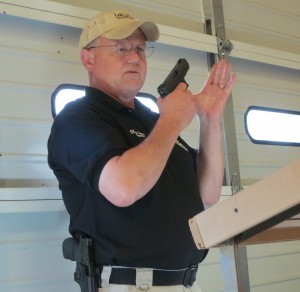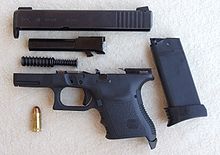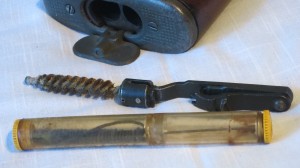Are you a recreational shooter or do you use your firearm for self-defense? There is some disagreement even among gun enthusiasts about how often a firearm should be cleaned – anywhere from after every single use to only after 1000 rounds. But, the reason for cleaning doesn’t change: the gun should work when we need it to.
Every time the gun is fired, a pin (or hammer) strikes the primer in the bullet and causes a spark. This spark ignites the powder in the bullet and causes an explosion, which moves the bullet down the barrel of the gun. Minute bits of gunpowder and lead residue are left behind in and outside the firearm and builds up over time. Gunpowder dust? Bullet dust? A bit of both. If left on and in the firearm and ignored, the handgun will most likely lose efficiency and reliability.
Imagine driving your car for a while without getting the plugs replaced, the filters changed or the oil changed. It might still run, but not as well as if you did the regular maintenance. And, it might even stall (or not start at all) for no apparent reason when you need it the most.
Cops on TV and in the movies do have occasional scenes where their guns don’t work and a partner has to come to the rescue. There may be lots of reasons for a handgun to misfire – lousy ammo, worn parts, dirty/rusty mechanisms, blocked barrel, cheaply made – but checking the gun on a regular basis can help avoid some of the common malfunctions.
There are three basic rules for safe handling of a firearm, whether you are showing it to someone, shooting it, putting it away, or you are about to clean it, and it’s good to practice them even when you think it’s unnecessary. There are too many accidental deaths caused by people cleaning their firearms, so please take note:
1 – always point the gun in a safe direction
2 – keep your finger OFF the trigger until you’re ready to shoot
3 – keep the gun UNLOADED unless and until you’re going to shoot
When you buy the gun, pick up a cleaning kit at the same time. Cleaning kits are not expensive – $20.00 will get you a basic kit that includes the metal rods and brushes you need to clean your handgun, along with cleaning patches and patch holders. There are several types of brushes to use, but most gun owners say that a toothbrush will work to do the overall initial cleaning, and twisted bronze brushes will work best for cleaning the bore. The bore brushes come in different sizes to fit the different caliber guns. A bore brush for a .45 won’t fit a .22, etc. Check the manufacturers catalog to see which brushes you need, if you don’t already know.
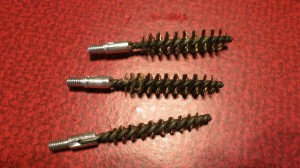
An interesting tool for cleaning a firearm is a Bore Snake.
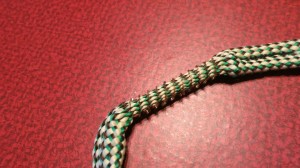
Because of its construction, it is possible to combine a couple of cleaning steps into one. The two ends (of what is essentially a very fat shoelace) are softer, with bronze bristles in the center. As the Bore Snake is pulled through (from back to front) of the bore, the soft end removes loose residue, the bronze wire on the Bore Snake loosens the more resistant grit, then the softer floss at the end pulls away the rest. It can be used with solvent, or pulled through dry.
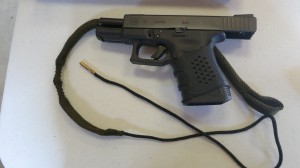
The Bore Snake can also double as a safe storage and transport aid. If the Bore Snake is in the bore, there’s no possibility that a bullet is in the chamber.
Steps to cleaning the firearm:
1. Check to make sure that the gun is unloaded.
2. Take apart the gun.
3. Wipe down all the parts to be cleaned, using cloth rags.
4. Apply a solvent recommended by your gun’s manufacturer to the dirty areas and let it sit for 2-3 minutes.
5. Scrub the entire gun, inside and out, with a soft brush to loosen the grime.
6. Wipe the gun clean with a solvent-soaked rag and repeat if necessary.
7. Use a bore brush (or the Bore Snake) to clean the bore, being careful to start at the back and move forward through the bore, without reversing direction while inside the barrel.
8. Use the solvent to clean the bore with a cotton patch or the Bore Snake.
9. After cleaning the gun, lubricate it.
10. Grease the sliding parts of the handgun.
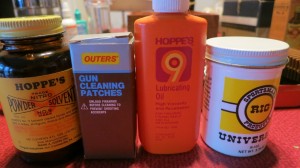
There are different oils and greases used during extreme weather (hot or cold) as well as in wet, humid conditions, so check with the gun manufacturer to see which product(s) will work best for your firearm.
Some military rifles are built so that cleaning supplies can be stowed in a special compartment in the stock.
We hear every once in a while about people shooting themselves while cleaning their firearms, sometimes with deadly consequences. It would seem impossible for these tragedies to occur if following standard gun safety rules, but sadly, people don’t always do that.
The best policy is to assume the gun is loaded and check each and every time before you clean it, to make sure you don’t shoot yourself or somebody else.
*First photo – (disassembled Glock) – from Wikipedia
Other photos by Patti Phillips
Photo of Glock with Bore Snake taken at Freedom Firearms Training, in Carthage, NC. Many thanks to Steve Jones and his staff for allowing me to visit during one of his concealed/carry permit classes.
Steve Jones is an experienced NRA firearms instructor and is the owner/operator of Freedom Firearms Training.
